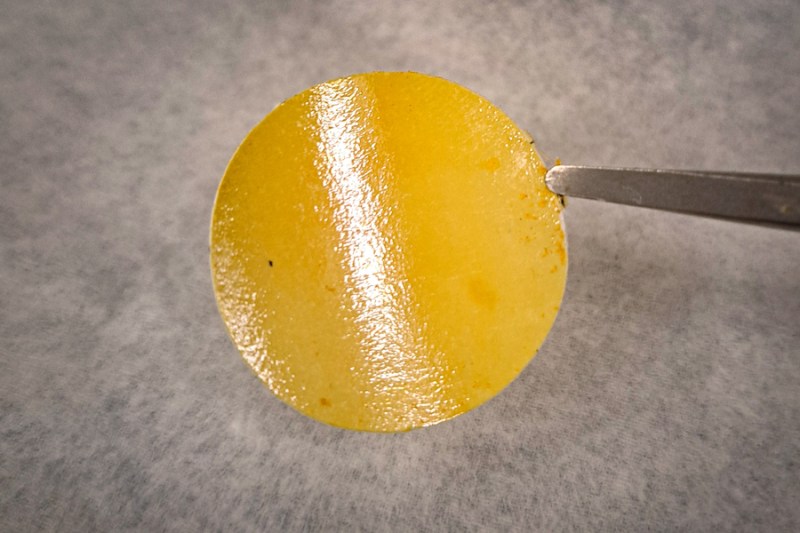Currently the typical way that crude oil is processed involves a fractional distillation column, in which heated crude oil is separated into the various hydrocarbon compounds using distinct boiling points. This requires the addition of significant thermal energy and is thus fairly energy intensive. A possible alternative has been proposed by [Tae Hoon Lee] et al. with a research article in Science. They adapted membranes used with reverse-osmosis filtration to instead filter crude oil into its constituents, which could enable skipping the heating step and thus save a lot of energy.
The main change that had to be made was to replace the typical polyamide films with polyimine ones, as the former have the tendency to swell up – and thus becomes less effective – when exposed to organic solvents, which includes hydrocarbons. During testing, including with a mixture of naphtha, kerosene and diesel, the polyimine membrane was able to separate these by their molecular size.
It should be noted of course that this is still just small scale lab-testing and the real proof will be in whether it can scale up to the flow rates and endurance required from a replacement for a distillation column. Since this research is funded in part by the fossil fuel industry, one can at least expect that some trial installations will be set up before long, with hopefully positive results.
















Fractional distillation is rarely used anymore. Almost all fuel “refining” is done with Catalytic Crackers. Not unlike the catalytic converter in a car breaking down unburned gasoline, crackers take crude oil that may have hydrocarbons with 35 carbons or more (paraffin) and cleave them down to ones with 8 carbons (octane) or even lighter (pentane, butane). Yes, crude oil can contain fractions all the way down to methane and butane, I know.
I drive past a fractional distillation column, however, every once in a while. The company running it takes spilled product, contaminated product, and all sorts of other junk that would wind up as hazmat and then separates it into marketable fractions. You can tell when it’s running because they flare off the butane. Maybe methane, I don’t know. Looks like Blade Runner, only smaller.
Hats off to the membrane tactic, BTW. Nice hack.
They use cracking to break up the heavier fractions into more useable lighter fractions. These lighter fractions still need distillation to seperate them.
Yes, a cracker turns some of the heavy oils into lighter fuels, to get more value out of the barrel of crude, but you still need the distillation tower to separate the components. Or maybe membranes now. We’ll see.
That’s what I thought too, this would work well cleaning up “junk”.
“Copperhead Road” was playing on the radio as I read this, so naturally I thought of moonshine stills blowing up.
I suspect a multi stage process would be needed: any membrane capable of passing ethanol would also pass ethanol (wood alcohol) and water.
I would assume a membrane that is passing ethanol would pass ethanol yes maybe you meant methanol
there will be a convergance of this type of technology and the catalitic cracking, along with useing solar powered catalitic reactions on sea water, and air, to allow the production or conversion of any carbon and hydrogen containing gases,solids and liquids at low temperatures and pressures.
there are a lot, as in a huge number of efforts world wide, working on every aspect of this.Any colinisation of mars will be completly dependent on this type of “universal chemistry” becoming very mature, light weight and energy efficient, not to mention the rather large terrestrial markets.
After the machines have risen up against us, this tech will be useful for cheaply converting the Earth’s residual biomass into useful chemicals and energy to feed the matrix.
Seems like an interesting first step. I appreciate all types of lateral thinking. My only concern is the stark difference between diesel naptha and kerosene mixed and crude oil. Having only seen crude oil once in my life, it is a vile sludgy mix. It contains an awful lot of stuff that I sincerely doubt is in that mixture and I can only imagine would gunk up a membrane in minutes.
I’m not here to say “this will never be useful” but I am skeptical. Still really cool!
I’ve worked extensively with membranes in industrial organic solvent nanofiltration and solvent recovery applications and fouling is definitely an issue with feedstocks that have a lot of gunk in them. They tend to be very sensitive to temperature, concentration level, and flow rate in high loading applications.
Generally they are run with many successive stages of varying filter types – a first one to remove your larger particulates and long chain stuff, then a tighter one to exclude some other group of compounds, and so on until you get down to your final solvent recovery membrane.
The residual sludge from each stage is interesting from a scientific and engineering perspective, and a real pain from a “poor bugger who has to clean it up” perspective.
Remind Me! 10 years.
This is a promising development but there’s a long way to go in the dirty business of oil fractionation – I think we may see lengthy trials on specific fractions before anyone commits to a full scale Crude to Product refinery based on this.
It is also very poor journalism to start with a breathless “really soon now” promotional release that is followed by a link to a paywalled article that nobody outside of the subscribers’ circle can read to decide for themselves.
20 years ago metal and composite (hardened) molecular sieves were the holy grail to replace fragile polymer membranes. Still waiting. Same for ceramic ultra filtration discs. Proven technology, just too expensive outside of exotic applications like hazardous waste processing.